Grow onions
Even if you don’t have the space to grow your own supply of fat brown bulbs, you need never be without an onion alternative. Its flavour and health benefits abound in a whole family of easily accommodated plants. The Allium family is also one of the gardens most decorative.
Spring Onions
Spring onions (aka bunching onions) are easy to grow for a constant, year round supply. While the green leaves of any onion can be used in cooking, the best for this purpose are the spring onion varieties, including an attractive red form. Seedlings are available most of the year, or grow them from seed sown directly in autumn or spring. They’re also easy to grow in pots.
Chives
Chives are very similar to spring onions. In a warm climate they can be grown all year round. In cold climates the leaves will die back in winter but return in spring. You can grow them from seed, buy seedlings or start new plants by dividing overcrowded clumps. Provided they are kept moist, they’re also easy to grow in pots.
Chive flowers are a delight – the pretty lilac pompoms make a colourful garden edging. However, their appearance marks a decline in the flavour of the leaves. The simple answer is to grow enough for both flowers and continuous picking.
Garlic chives have flat leaves with a mild garlic flavour and white flowers.
Shallots
Subtle, sweet and sophisticated, shallots offer a delicate onion flavour popular in Mediterranean dishes and lovely in sauces or roasted with chicken. They are classified as small onions and can be grown from seed, but also from cloves planted like garlic in autumn or early winter. Plant the cloves, 15-20cm apart, in well- prepared soil so that their tops are just level with the soil surface. The leaves can be used like chives while still green. Harvest the bulbs in summer keeping the smallest cloves for replanting.
Onions
Onions can take up to eight months from sowing to harvesting, depending on when you plant, where you live and which variety you grow. It is important to plant the right variety for the season and climate, or plants may run to seed too early. Although some fast maturing varieties can be grown all year round in the warmest areas, onions are traditionally planted in autumn or winter for summer harvest. They prefer cooler temperatures in the seedling stage, then warm dry conditions once bulbs start to form.
Day length determines when the different varieties begin to form bulbs. By planting both early and late varieties you can achieve a year round supply. The first to be planted are the early varieties, which are harvested in early summer. Later maturing varieties will keep longest in storage. Sow seed directly into well-prepared soil, or to save space in the garden over winter, sow them in trays and plant out in spring. Direct sown seedlings can be thinned as they grow.
Onions thrive on a generous supply of nutrients. A few weeks prior to planting, dig in well-rotted manure or sheep pellets. In most cases, garden lime (60-100g per square metre) is beneficial. Add lime and let it wash into the soil prior to sowing, at least a couple of weeks before applying general garden fertiliser.
Leeks
Leeks are faster growing than regular onions but allow a good six months from sowing to maturity. They’re best sown in warm areas in autumn and cooler areas from early spring to mid-summer. Alternatively, seedlings are available in punnets. Side dress with high-nitrogen fertiliser as leeks grow.
Multiplying leeks are ideal where space is limited and can be grown in a pot. Stems are similar to spring onions, but form a tight clump and grow year round. Divide the clump occasionally and they’ll keep on keeping on!
Garlic
Most of us love garlic for its culinary brilliance but if you suffer from high cholesterol, high blood pressure, skin blemishes, sore throats or intestinal parasites, you may well benefit from a bountiful supply of garlic. Garlic also grows well in a large pot or window box. The general rule of thumb is to plant on the shortest day and harvest on the longest. In warm climates it can be planted earlier, while in very cold climates it’s best to plant in spring when the risk of frost has passed.
How to grow garlic
- Purchase fresh clean, locally grown garlic bulbs (imported bulbs from grocers will have been fumigated). Separate bulbs into cloves, discarding any damaged ones. The fat, outside cloves are best for planting.
- Choose a sunny spot with well-drained soil, rich in organic matter. The soil should be moist, not cold or wet.
- Add a handful of lime per square metre. For garlic in pots, use container mix with a tablespoon of lime mixed in.
- Plant cloves 2.5cm deep, about 10cm apart. Elephant garlic is best planted about 30cm apart.
Did you know?
- The component that gives garlic its famous odour, is also responsible for inhibiting bacteria in the human body, as well as pesky bugs in the garden. It’s a compound called allicin, which is formed when garlic is crushed. Allicin is damaged with cooking which means garlic is healthiest when eaten raw!
- Not only is garlic legendary as a weapon against vampires – but equally effective if you have a population of aphids sucking the life from your garden. Garlic is a well-known pest repellent, either applied as a spray or planted as a companion plant.
- Early American settlers used wild onions to treat colds, coughs, and asthma, and to repel insects. In Chinese medicine, onions have been used to treat angina, coughs, bacterial infections, and breathing problems.
- Studies have shown a high consumption of onions, garlic and other allium herbs to be protective against stomach and other cancers.
- Onions diminish the risk of blood clots and may help prevent cardiovascular disease.
- The stronger the flavour, the more superior the health-promoting properties!
16-May-2016
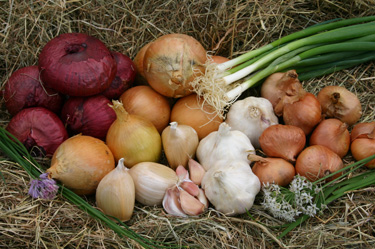
The edible Onion family
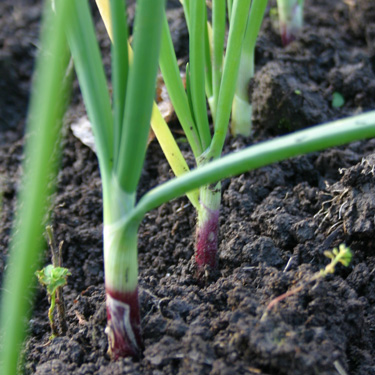
Onion seedlings
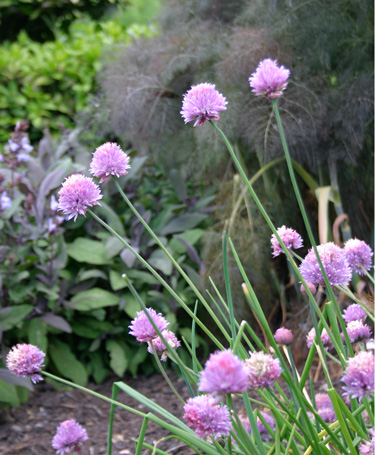
Chives in flower
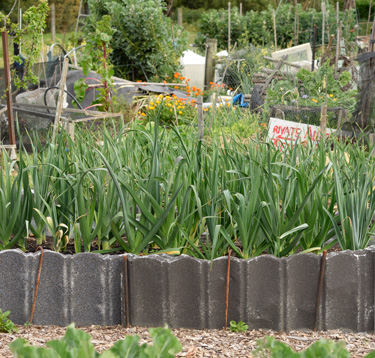
Leeks
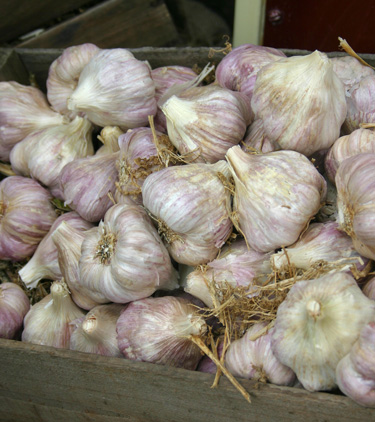
Harvested garlic


